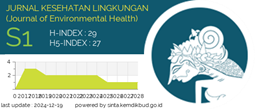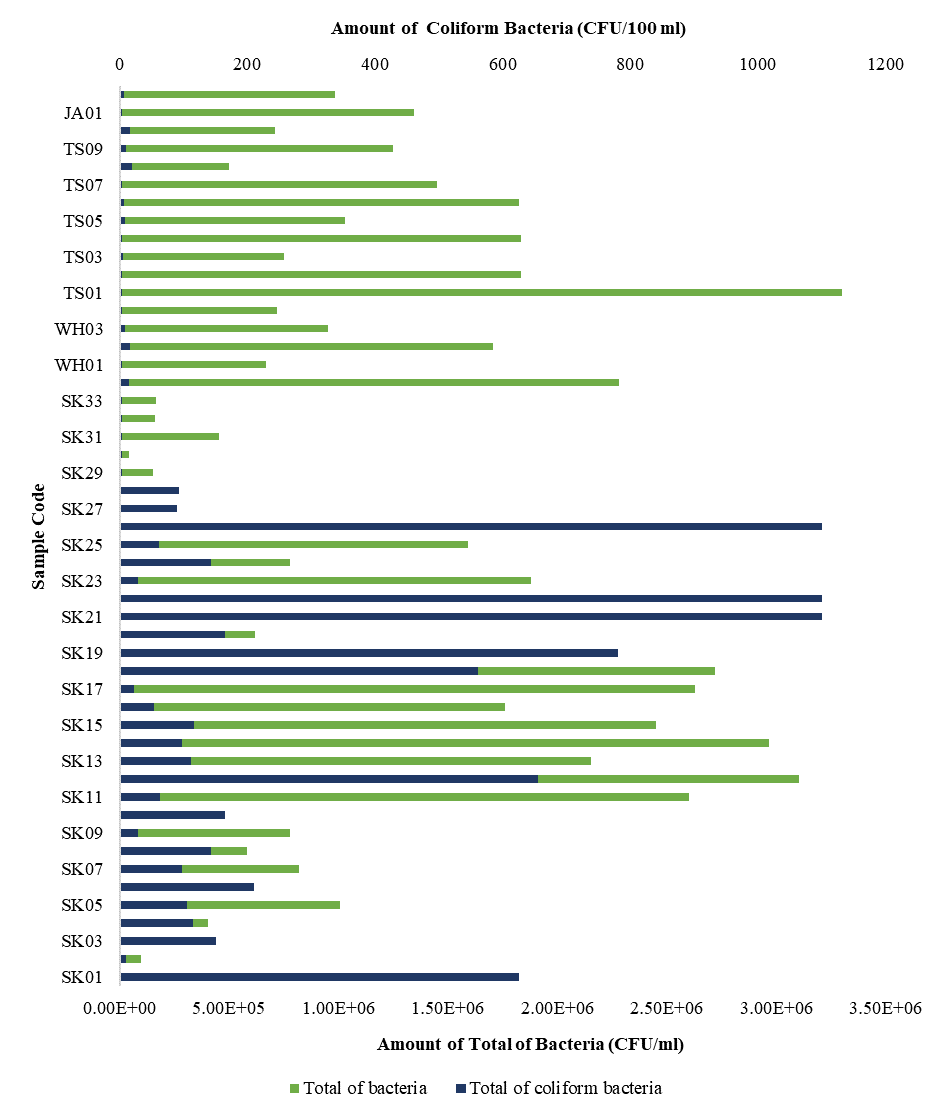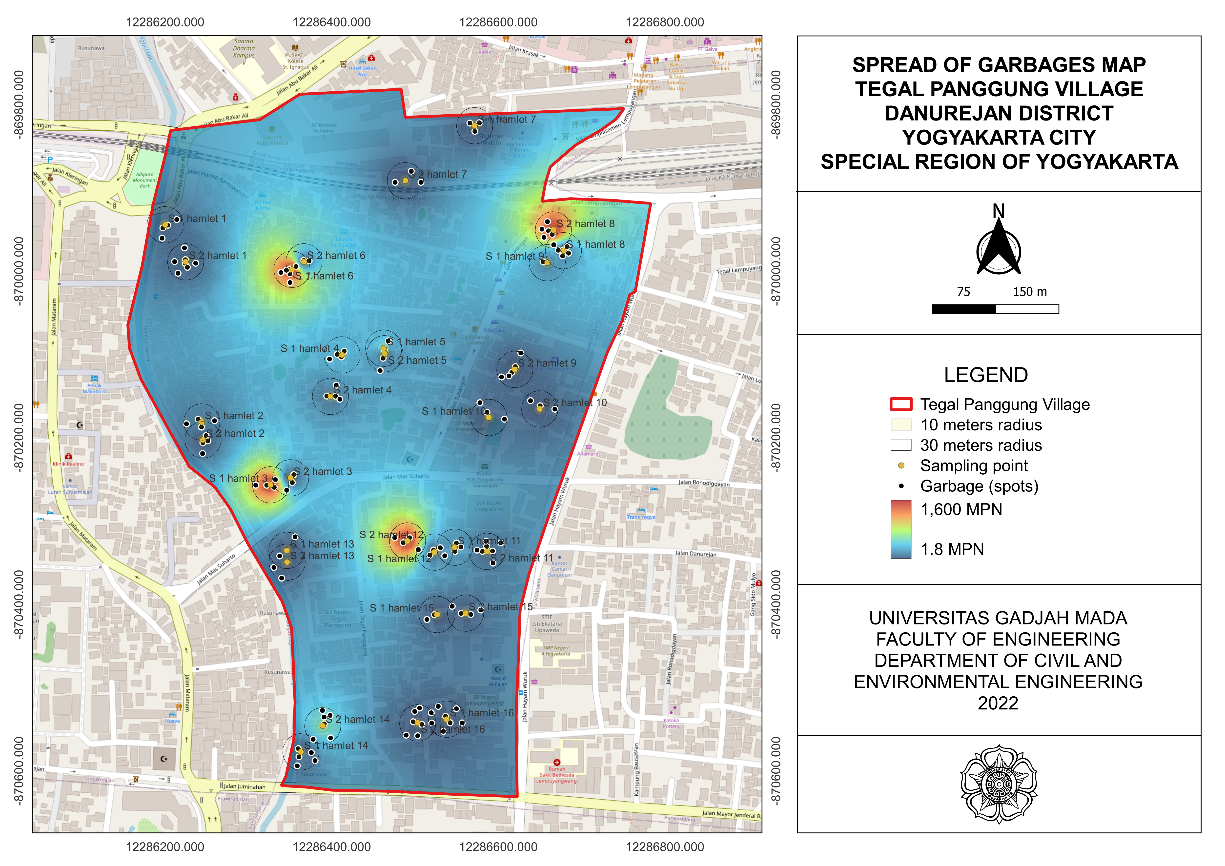Assessment of the Potential Health Risks Associated with the Plumbum, Cadmium, Zinc and Nickel Content in Fish Tissue Collected from Retention Pond

Introduction: The presence of heavy metals in fish constitutes a potential health risk to human consumers. This research aims to address this issue by determining the concentration of heavy metals in fish samples collected from retention ponds and assessing potential health risks for those who consume fish caught from the ponds. The primary objectives involve assessing the concentrations of heavy metals in fish tissues. Additionally, the study aim to evaluate potential health risks. Methods: The Atomic Absorption Spectrophotometer was employed to quantify heavy metal concentrations, while health risk assessments were based on EDI, THQ, HI, and CR calculations. Results and Discussion: The findings indicate a metal distribution pattern in the order of Zn> Pb> Ni> Cd and the observed value is lower than the maximum level permitted by FAO. The THQ and HI values for all studied metals were found to be below 1, signifying a lack of adverse non-carcinogenic health effects on consumers. At the same time, the cancer risk values for examined heavy metals are well below the value 10-4 which is consider as acceptable cancer risk, except Ni. CR value for Ni was recorded higher than 10-4 approaching higher limit of acceptable limit, suggesting a heightened cancer risk for consumers who consume these fish throughout their entire lifespan. Conclussion: The findings from this research have significant implications, contributing to various aspects of public health, environmental management, and regulatory measures.
Contamination by Heavy Metals and their Toxic Effect on Aquaculture and Human Health Through Food Chain. Letters in Applied NanoBioScience. 2020;10(2):2148-2166. https://doi.org/10.33263/LIANBS102.21482166
Agbugui MO, Abe GO. Heavy Metals in Fish: Bioaccumulation and Health. British Journal of Earth Sciences Research. 2022;10(1):47-66. https://doi.org/10.37745/bjesr.2013
Lu J, Lin Y, Wu J, Zhang C. Continental-scale Spatial Distribution, Sources, and Health Risks Of Heavy Metals In Seafood: Challenge For The Water-Food-Energy Nexus Sustainability In Coastal Regions?. Environmental Science and Pollution Research. 2021;28(1):63815-63828 https://doi.org/10.1007/s11356-020-11904-8
Liu Q, Xu X, Zeng J, Shi X, Liao Y, Du P, et al. Heavy Metal Concentrations in Commercial Marine Organisms from Xiangshan Bay, China, and The Potential Health Risks. Marine Pollution Bulletin. 2019;141(1):215-226. https://doi.org/10.1016/j.marpolbul.2019.02.058
Rehman K, Fatima F, Waheed I, Akash MS. Prevalence of Exposure of Heavy Metals and Their Impact on Health Consequences. Journal of Cellular Biochemistry. 2018;119(1):157-184. https://doi.org/10.1002/jcb.26234
Abera BD, Adimas MA. Health Benefits and Health Risks of Contaminated Fish Consumption: Current Research Outputs, Research Approaches, And Perspectives. Heliyon. 2024;10(13):1-16. https://doi.org/10.1016/j.heliyon.2024.e33905
Emenike EC, Iwuozor KO, Anidiobi SU. Heavy Metal Pollution in Aquaculture: Sources, Impacts and Mitigation Techniques. Biological Trace Element Research. 2022:200(10):4476-4492. https://link.springer.com/article/10.1007%2Fs12011-021-03037-x
Gao P, Mohd Noor NQ, Md. Shaarani S. Current Status of Food Safety Hazards and Health Risks Connected with Aquatic Food Products From Southeast Asian Region. Critical Reviews in Food Science and Nutrition. 2022;62(13):3471-3489. https://doi.org/10.1080/10408398.2020.1866490
Linderhof V, De Lange T, Reinhard S. The Dilemmas of Water Quality and Food Security Interactions in Low-And Middle-Income Countries. Frontiers in Water. 2021;3(1):1-17. https://doi.org/10.3389/frwa.2021.736760
Tek PP, Ng CC. Accumulation of Potentially Toxic Elements in Fourfinger Threadfin (Eleutheronema tetradactylum) and Black Pomfret (Parastromateus niger) from Selangor, Malaysia. Environmental Monitoring and Assessment. 2024;196(4):1-16. https://doi.org/10.1007/s10661-024-12508-2
Kazemi A, Esmaeilbeigi M, Ansari A, Asl AG, Mohammadzadeh B. Alterations and Health Risk Assessment of The Environmental Concentration of Heavy Metals in The Edible Tissue of Marine Fish (Thunnus tonggol) Consumed by Different Cooking Methods. Regional Studies in Marine Science. 2022;53(1):1-10. https://doi.org/10.1016/j.rsma.2022.102361
Ferreira SL, Cerda V, Cunha FA, Lemos VA, Teixeira LS, dos Santos WN, et al. Application of Human Health Risk Indices in Assessing Contamination From Chemical Elements in Food Samples. TrAC Trends in Analytical Chemistry. 2023;167(1):1-9. https://doi.org/10.1016/j.trac.2023.117281
Kortei NK, Heymann ME, Essuman EK, Kpodo FM, Akonor PT, Lokpo SY, et al. Health Risk Assessment and Levels of Toxic Metals in fishes (Oreochromis noliticus and Clarias anguillaris) from Ankobrah and Pra basins: Impact of Illegal Mining Activities on Food Safety. Toxicology Reports. 2020;7(1):360-369. https://doi.org/10.1016/j.toxrep.2020.02.011
Younis AM, Hanafy S, Elkady EM, Alluhayb AH, Alminderej FM. Assessment of Health Risks Associated with Heavy Metal Contamination in Selected Fish and Crustacean Species from Temsah Lake, Suez Canal. Scientific Report. 2024;14(1):1-16. https://doi.org/10.1038/s41598-024-69561-7
Li J, Miao X, Hao Y, Xie Z, Zou S, Zhou C. Health Risk Assessment of Metals (Cu, Pb, Zn, Cr, Cd, As, Hg, Se) in Angling Fish with Different Lengths Collected from Liuzhou, China. International Journal of Environmental Research and Public Health. 2020;17(7):1-16. https://doi.org/10.3390/ijerph17072192
Damir N, Coatu V, Danilov D, Lazăr L, Oros A. From Waters to Fish: A Multi-Faceted Analysis of Contaminants’ Pollution Sources, Distribution Patterns, and Ecological and Human Health Consequences. Fishes. 2024;9(7):1-32. https://doi.org/10.3390/fishes9070274
Zhang H, Chen Y, Li D, Yang C, Zhou Y, Wang X, Zhang Z. PAH Residue and Consumption Risk Assessment In Four Commonly Consumed Wild Marine Fishes from Zhoushan Archipelago, East China Sea. Marine Pollution Bulletin.2021;170(1):1-6. https://doi.org/10.1016/j.marpolbul.2021.112670
Anyahara JN. Effects of Polycyclic Aromatic Hydrocarbons (PAHs) on The Environment: A Systematic Review. International Journal of Advanced Academic Research.2021;7(3):12-26 www.doi.org/10.46654/ij.24889849.e7303
Adegbola PI, Adetutu A. Genetic and Epigenetic Modulations in Toxicity: The Two-Sided Roles of Heavy Metals and Polycyclic Aromatic Hydrocarbons From The Environment. Toxicology Reports. 2024;12(1):502-519. https://doi.org/10.1016/j.toxrep.2024.04.010
Emmanuel UC, Chukwudi MI, Monday SS, Anthony AI. Human Health Risk Assessment of Heavy Metals in Drinking Water Sources In Three Senatorial Districts of Anambra State, Nigeria. Toxicology reports. 2022;9(1):869-875. https://doi.org/10.1016/j.toxrep.2022.04.011
United States Environmental Protection Agency (USEPA). Risk Assessment Guidelines for Carcinogens. Washington DC: USEPA; 2024. https://www.epa.gov/fera/risk-assessment-carcinogenic-effects
Abd Manan TS, Khan T, Mohtar WH, Beddu S, Qazi S, Khozani ZS, et al. Ecological and Health Risk Assessment of Polycyclic Aromatic Hydrocarbons (PAHs) in Sungai Perak, Malaysia. Journal of Cleaner Production. 2021;294(1):1-13. https://doi.org/10.1016/j.jclepro.2021.126124
Venkatraman G, Giribabu N, Mohan PS, Muttiah B, Govindarajan V, Alagiri M, et al. Environmental Impact and Human Health Effects of Polycyclic Aromatic Hydrocarbons and Remedial Strategies: A Detailed Review. Chemosphere. 2024;351(1):1-13. https://doi.org/10.1016/j.chemosphere.2024.141227
Babuji P, Thirumalaisamy S, Duraisamy K, Periyasamy G. Human Health Risks Due to Exposure to Water Pollution: A Review. Water. 2023;15(14):1-15. https://doi.org/10.3390/w15142532
Sharma AK, Sharma M, Sharma AK, Sharma M. Mapping the Impact of Environmental Pollutants On Human Health and Environment: A Systematic Review And Meta-Analysis. Journal of Geochemical Exploration. 2023; 255(1):1-27. https://doi.org/10.1016/j.gexplo.2023.107325
Chasapis CT, Ntoupa PS, Spiliopoulou CA, Stefanidou ME. Recent Aspects of The Effects of Zinc on Human Health. Archives of Toxicology. 2020;94(1):1443-1460. https://doi.org/10.1007/s00204-020-02702-9
Lall SP, Kaushik SJ. Nutrition and Metabolism of Minerals in Fish. Animals. 2021;11(9):1-41. https://doi.org/10.3390/ani11092711
Ma S, Wang WX. Significance of Zinc Re-28. Absorption in Zn Dynamic Regulation in Marine Fish Revealed by Pharmacokinetic Model. Environmental Pollution. 2024;363(1):1-10. https://doi.org/10.1016/j.envpol.2024.125106
Pan B, Wang Y, Li D, Wang T, Du L. Tissue- Specific Distribution and Bioaccumulation Pattern of Trace Metals in Fish Species from The Heavily Sediment-Laden Yellow River, China. Journal of Hazardous Materials. 2022;425(1):1-15. https://doi.org/10.1016/j.jhazmat.2021.128050.
Mandal GC, Mandal A, Chakraborty A. The Toxic Effect of Lead on Human Health: A Review. Human Biology and Public Health. 2022;3(1):1-11. https://doi.org/10.52905/hbph2022.3.45
Collin MS, Venkatraman SK, Vijayakumar N, Kanimozhi V, Arbaaz SM, Stacey RS, et al. Bioaccumulation of Lead (Pb) and Its Effects on Human: A Review. Journal of Hazardous Materials Advances. 2022;7(1):1-8. https://doi.org/10.1016/j.hazadv.2022.100094
Genchi G, Carocci A, Lauria G, Sinicropi MS, Catalano A. Nickel: Human Health and Environmental Toxicology. International Journal of Environmental Research and Public Health. 2020;17(3):1-21. https://doi.org/10.3390/ijerph17030679
Resma NS, Meaze AM, Hossain S, Khandaker MU, Kamal M, Deb N. The Presence of Toxic Metals in Popular Farmed Fish Species and Estimation of Health Risks Through Their Consumption. Physics Open. 2020;5(1):1-7. https://doi.org/10.1016/j.physo.2020.100052
Zaghloul GY, Eissa HA, Zaghloul AY, Kelany MS, Hamed MA, Moselhy KM. Impact of Some Heavy Metal Accumulation in Different Organs on Fish Quality from Bardawil Lake and Human Health Risks Assessment. Geochemical Transactions. 2024;25(1):1-20 https://doi.org/10.1186/s12932-023-00084-2
Santa Maria MP, Hill BD, Kline J. Lead (Pb) Neurotoxicology and Cognition. Applied Neuropsychology: Child. 2019;8(3):272-293. https://doi.org/10.1080/21622965.2018.1428803
Resma NS, Meaze AM, Hossain S, Khandaker MU, Kamal M, Deb N. The Presence of Toxic Metals in Popular Farmed Fish Species and Estimation of Health Risks Through Their Consumption. Physics Open. 2020;5(1):1-7 .https://doi.org/10.1016/j.physo.2020.100052
Łuczyńska J, Paszczyk B, Łuczyński MJ. Fish As A Bioindicator Of Heavy Metals Pollution In Aquatic Ecosystem Of Pluszne Lake, Poland, and Risk Assessment For Consumer’s Health. Ecotoxicology and Environmental Safety. 2018;153(1):60-67. https://doi.org/10.1016/j.ecoenv.2018.01.057
Noman MA, Feng W, Zhu G, Hossain MB, Chen Y, Zhang H, Sun J. Bioaccumulation and Potential Human Health Risks of Metals in Commercially Important Fishes and Shellfishes from Hangzhou Bay, China. Scientific Reports. 2022;12(1):1-15. https://doi.org/10.1038/s41598-022-08471-y
Töre Y, Ustaoğlu F, Tepe Y, Kalipci E. Levels of Toxic Metals in Edible Fish Species of the Tigris River (Turkey); Threat to Public Health. Ecological Indicators. 2021;123(1):1-9. https://doi.org/10.1016/j.ecolind.2021.107361
EFSA Panel on Contaminants in the Food Chain (CONTAM), Schrenk D, Bignami M, Bodin L, Chipman JK, Del Mazo J, Grasl Kraupp B, et al. Update of The Risk Assessment of Nickel in Food and Drinking Water. EFSA Journal. 2020;18(11):1-101. https://doi.org/10.2903/j.efsa.2020.6268
Lin Z, Xu X, Xie M, Chen R, Tan QG. Measuring Metal Uptake and Loss In Individual Organisms: A Novel Double Stable Isotope Method and Its Application in Explaining Body Size Effects On Cadmium Concentration In Mussels. Environmental Science & Technology. 2021;55(14):9979-9988. https://doi.org/10.1021/acs.est.1c01582

This work is licensed under a Creative Commons Attribution-NonCommercial-ShareAlike 4.0 International License.
1. Copyright of all journal manuscripts is held by the Jurnal Kesehatan Lingkungan.2. Formal legal provisions to access digital articles of electronic journal are subject to the provision of the Creative Commons Attribution-ShareAlike license (CC BY-NC-SA), which means that Jurnal Kesehatan Lingkungan is rightful to keep, transfer media/format, manage in the form of databases, maintain, and publish articles.
3. Published manuscripts both printed and electronic are open access for educational, research, and library purposes. Additionally, the editorial board is not responsible for any violations of copyright law.
JKESLING by UNAIR is licensed under a Creative Commons Attribution-ShareAlike 4.0 International License.







































